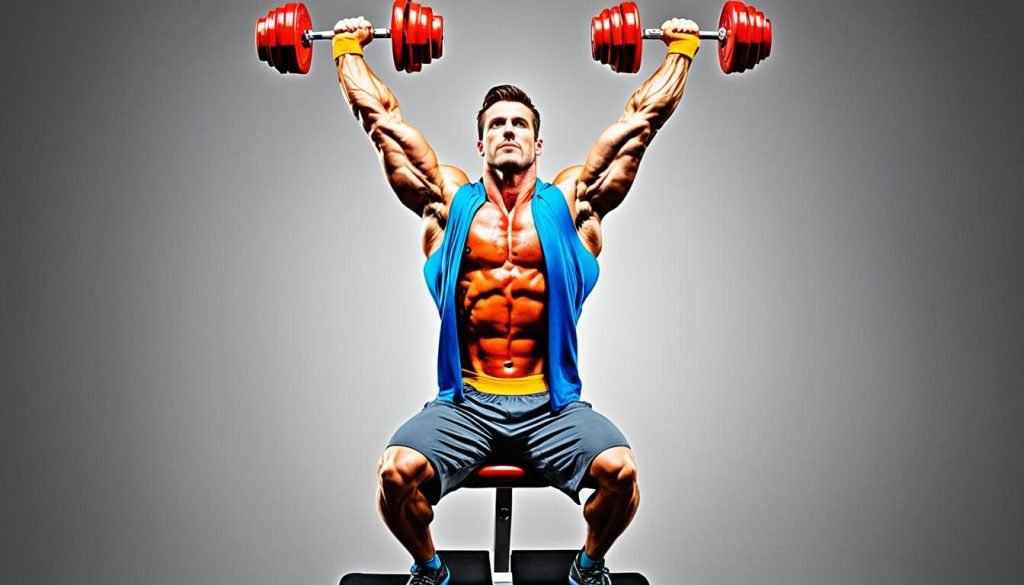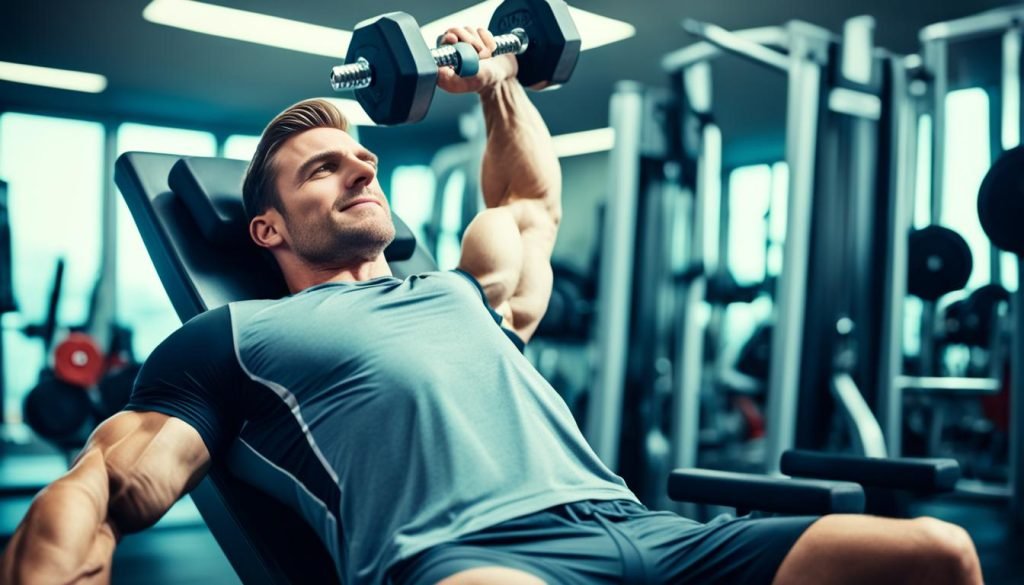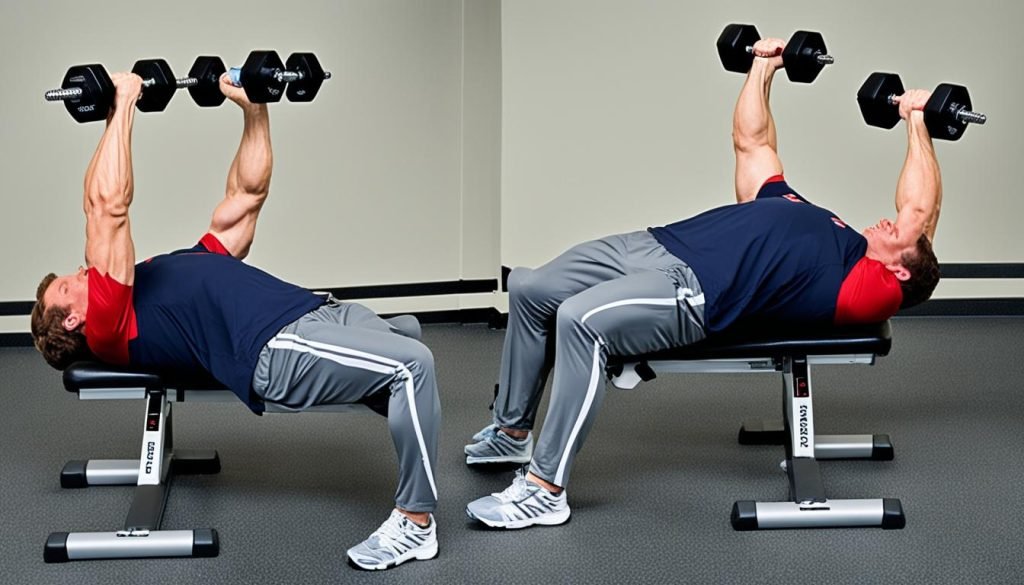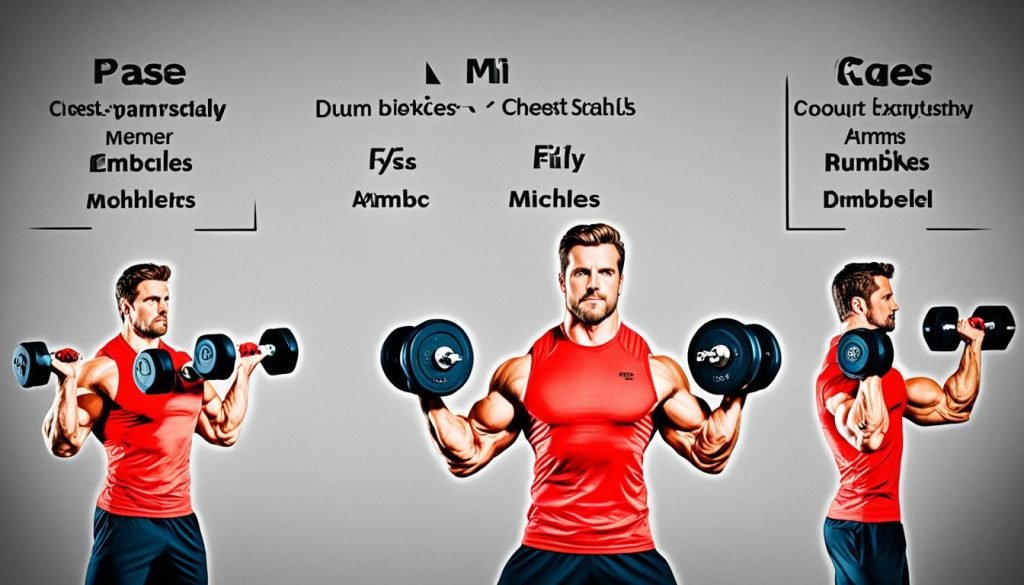Are you making the most of your muscle growth with the right dumbbell chest press moves, or just doing the same old thing? Learning about different dumbbell workouts can change your upper body strength training for the better. We'll look at key dumbbell chest press moves that boost your performance and help you grow muscles better. You'll see how flat, incline, and decline presses work differently to target your chest muscles. This leads to balanced muscle growth and bigger gains.
Key Takeaways
- Dumbbell chest press variations are key for muscle growth and strength.
- Dumbbells help with balanced muscle growth, unlike traditional barbells.
- How you do each move affects muscle activation and growth.
- Incline and decline presses focus on specific chest areas for full training.
- Trying different workouts keeps your training interesting and effective.
- Steering clear of common mistakes makes your training safer and more effective.
Understanding the Importance of Chest Press Variations
Using different chest press variations in your workout is key for muscle growth. Doing the same exercise over and over can stop your muscles from getting bigger. Mixing up your exercises keeps your workouts fun and challenges your body in new ways.
Why Changing Up Your Routine Matters
Changing your strength training is vital for muscle growth. It stops your body from getting too used to the same exercises. This way, more muscle fibers get worked, including ones not fully used before.
Using different grips and angles, like flat, incline, or decline, makes your workouts better. It leads to bigger gains.
Tricking Muscle Fibers for Continued Growth
Targeting specific muscle fibers is crucial for more strength. Using various grips—pronated, neutral, and rotational—works different parts of the chest muscles. This helps prevent injuries and boosts strength.
Switching these elements often makes your training better. It helps your muscles grow and get stronger.
| Type of Press | Muscle Targeted | Grip Variation |
|---|---|---|
| Flat Bench Press | Overall Chest | Pronated |
| Incline Bench Press | Upper Chest | Neutral |
| Decline Bench Press | Lower Chest | Rotational |
| Dumbbell Fly | Chest Isolation | Pronated |
| Dumbbell Floor Press | Triceps and Chest | Neutral |
Dumbbell Chest Press Variations: Introduction
Dumbbells offer unique benefits for workouts, especially for the dumbbell flat bench press. They let people boost their upper body strength by moving more freely. This movement helps work out stabilizing muscles, making workouts safer and more balanced for each arm.
Benefits of Using Dumbbells Over Barbells
Using dumbbells has many advantages that make workouts better. Here are the main reasons why dumbbells are a top choice:
- Increased Range of Motion: Dumbbells let you move more during exercises, which helps activate muscles deeper.
- Improved Muscle Activation: They work more stabilizing muscles, leading to stronger workouts.
- Reduced Risk of Injury: The even load on each side lowers the risk of strain from barbells.
- Variety in Workouts: Dumbbells allow for many exercises, keeping workouts interesting and promoting steady progress.
Adding dumbbell exercises, like the dumbbell flat bench press, helps build muscle and fix muscle imbalances. These workouts improve overall upper body strength training.

Dumbbell Flat Bench Press
The dumbbell flat bench press is key for building strength in the upper and middle of the chest muscles. Learning how to do it right can boost your muscle activation and fitness performance. This part covers the right way to do it and what mistakes to avoid.
Execution and Muscle Activation
Start by lying flat on a bench with your feet on the ground. Hold a dumbbell in each hand, with the weights above your chest and palms facing forward. Keep your core tight to stay stable during the lift.
Lower the dumbbells slowly and in a straight line to your chest. This helps work your chest muscles well and keeps your shoulders safe.
Common Mistakes to Avoid
There are a few mistakes that can make the dumbbell flat bench press less effective. These include:
- Lifting the dumbbells too wide, which can hurt your shoulder joint.
- Dropping your elbows too much, putting stress on your shoulders.
- Using speed instead of muscle power to lift the weights.
- Not engaging your core, leading to poor stability and form.
Avoiding these mistakes will help you get better muscle activation and results from your workouts.
Dumbbell Incline Press
The dumbbell incline press is great for working on the upper chest muscles. By using a 30 or 45-degree angle bench, it targets the upper fibers of the pectoralis major. This helps in developing those muscles well. It's important to do it right to get the most out of it.
Targeting Upper Chest Muscles
This exercise works not just the upper chest but also the anterior deltoids. The incline bench angle focuses on the upper pectoral fibers. This makes it a key move for a balanced chest look. Adding it to your workout can really improve your upper body's look.
Performing the Incline Press Correctly
Getting the form right is key to avoiding injuries and doing well. Start by lying on an incline bench with a dumbbell in each hand. Keep your feet on the ground for balance. Press the dumbbells up with a slight elbow bend, focusing on smooth movement.
Avoid arching your back or using force, as these can hurt muscle work and increase injury risk.

Doing this exercise with care helps grow your upper chest muscles and boosts overall upper body strength. With effort and practice, the dumbbell incline press can be a key part of your workout.
Dumbbell Decline Press
The dumbbell decline press is a key exercise for the lower chest. It offers unique benefits for strength training. It helps improve chest development and definition by targeting the lower pectoral muscles.
Benefits of Focusing on Lower Chest
Working out the lower chest has many benefits for a balanced physique. These benefits include:
- Improved Aesthetics: A strong lower chest makes your chest look better balanced.
- Heavier Lifts: This exercise lets you lift more weight, which helps muscles grow.
- Reduced Shoulder Strain: It puts less stress on your shoulders, making it safer for those with shoulder issues.
Tips for Effective Execution
Here are tips for doing the dumbbell decline press right:
- Bench Position: Use a bench that declines to target the right muscles.
- Dumbbell Grip: Hold the dumbbells close to your chest before pressing them up.
- Core Engagement: Keep your core muscles tight to stay stable.
- Controlled Movement: Don't let your elbows drop too much to protect your shoulders and work your muscles well.

Dumbbell Fly Variations for Maximum Impact
Dumbbell fly variations are key to a great chest workout, helping with muscle growth. They focus on stretching and contracting the chest muscles. This includes the pectorals, anterior deltoids, and triceps. It makes for a well-rounded upper body workout.
The traditional fly, pullover, and alternating fly are top picks for their unique benefits. Each targets different chest areas. This helps with balanced muscle growth and avoids strength and size imbalances. Adding these exercises to your routine can boost your performance and looks.
To get the most out of dumbbell fly variations, follow these tips:
- Focus on controlled movements to ensure full range of motion.
- Keep your elbows slightly bent to avoid strain on the shoulder joints.
- Incorporate varying angles to target different parts of the chest.
These variations not only increase muscle growth but also make your workouts more interesting. By mixing up your routine, you keep things fresh and reach your fitness goals.

| Dumbbell Fly Variation | Target Muscles | Execution Tips |
|---|---|---|
| Traditional Fly | Pectoralis Major, Anterior Deltoids | Maintain a slight bend in elbows; lower weights until arms are parallel to the ground. |
| Pullover | Pectoralis Major, Lats | Focus on stretching the chest and back muscles; keep core engaged. |
| Alternating Fly | Pectoralis Major | Lift one dumbbell while keeping the other lowered for constant tension on each side. |
Conclusion
Adding different dumbbell chest press exercises to your workout is key for muscle growth and upper body strength. Each exercise, like flat, incline, decline, or flies, targets various muscle fibers. Mixing up your chest press exercises makes your workouts more effective and fun.
Being consistent is crucial in your fitness journey. Focus on doing exercises right and changing your routines often. This approach will boost your looks and strength. As you get better at these exercises, you'll see improvements in your overall fitness and health.
Using dumbbells wisely can take your chest training to the next level. By focusing on muscle growth with different exercises, you'll have a balanced and effective workout. This will help you reach your fitness goals and keep you moving forward.
FAQ
What are the different dumbbell chest press variations?
The main types include the dumbbell flat bench press, incline press, decline press, fly variations, and the pullover. Each targets different chest muscles, helping with upper body strength.
How do I perform the dumbbell flat bench press correctly?
Start by lying flat on the bench. Hold the dumbbells above your chest with a neutral grip. Press them up while keeping your core tight. Make sure your movements are controlled and don't flare your elbows.
Why is the dumbbell incline press important?
The incline press works on the upper chest and anterior deltoids. It's done at a 30 to 45-degree angle. This helps build a balanced and attractive chest.
What advantages do dumbbells offer over traditional barbells?
Dumbbells let you move more freely and work your stabilizing muscles better than barbells. This leads to balanced workouts for each arm, helping muscle growth and reducing injury risks.
How do I incorporate dumbbell fly variations into my routine?
Add dumbbell fly variations like the traditional fly, pullover, and alternating fly after your pressing exercises. Focus on stretching and contracting to fully engage your muscles and support balanced growth.
What common mistakes should I avoid when performing these exercises?
Avoid using too much weight, having bad form (like arching your back or dropping your elbows), and not using your core. Good form is key to preventing injuries and fully activating your muscles.
How often should I change my chest press routine?
Change your chest press routine every 4 to 6 weeks. This prevents plateaus, keeps muscles responsive, and supports ongoing muscle growth.
Can dumbbell exercises help with muscle imbalances?
Yes, dumbbell chest press exercises can fix muscle imbalances. They make both arms work independently, ensuring even strength on both sides of the body.
Source Links
- 19 Variations Of The Dumbbell Chest Press | Anywhere Fitness – https://www.anywherefitness.ie/blog/19-variations-of-the-chest-press-exercise
- 9 Muscle-Pumping Dumbbell Chest Workouts | Garage Gym Reviews – https://www.garagegymreviews.com/dumbbell-chest-workout
- Dumbbell Chest Press Variations | AFA Blog – https://www.fitnesseducation.edu.au/blog/fitness/dumbbell-chest-press-variations/
Recent Posts
It's important to evaluate whether Beachbody On Demand continues to meet your fitness needs as we enter 2025. With a range of workout programs and nutrition plans, the platform claims to cater to...
Just like having a personal trainer at your fingertips, Beachbody On Demand offers you an extensive library of on-demand workout programs accessible anytime, anywhere. This service allows you to...

